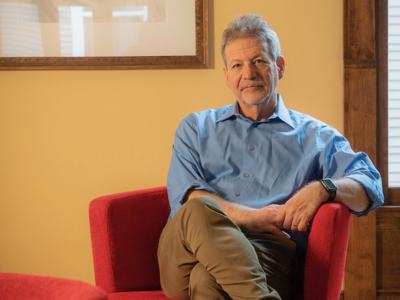For many Jewish organizations, it has become clear that older adults are happier if they can live independently and “age in place,” in their own homes rather than in nursing homes.
“It has been a longstanding priority of Jewish federations and affiliated agencies to encourage aging in place, the feeling being that when older adults age in place, as distinct from being in an institution, they are able to live healthier and fuller lives,” says William Daroff, senior vice president of public policy and director of the Washington Office of the Jewish Federations of North America (JFNA).
It is also more cost-effective to age in place because medical costs skyrocket for seniors who move to nursing homes or other facilities, Daroff explains.
Social isolation is a concern of aging in many living situations, whether an elderly person is living alone or is no longer part of his or her community of choice. One initiative addressing this problem is the Naturally Occurring Retirement Communities (NORC) program, based on the JDC-ESHEL program, which has been working with the elderly in Israel since 1969.
A group of Jewish federations started NORCs in response to a federal initiative to develop replicable models to deal with the coming increase in the senior population. While neighborhoods and apartment buildings transition from younger families with children to a preponderance of residents in their 70s and 80s, seniors begin to need outside help to stay in their homes.
“The idea behind NORCs is rather than remove them from that building or neighborhood, you bring the services to them,” says Daroff.
Karen Berry-Elbert manages St. Louis NORC, which launched in 2002 in a neighborhood with 4,300 total residents, including 1,300 who were 65 and older. The NORC’s two foundational premises are socialization and health and wellness. Reflecting research that says socializing is one of the keys to good health, all NORC bus trips into the community end with a meal together.
“If your mood is good, if you are engaged with people and in activities, you are going to feel good and there is some causal relation between your emotional health and your physical health,” Berry-Elbert says. To ensure that its non-driving members make it to programs, the NORC received funding for taxis to give them rides.
Programs to support health and wellness include health education, fitness classes, JCC membership discounts, walking groups, and safety modifications in people’s homes. The NORC also makes home visits to residents, performs general case management, and holds monthly blood pressure screenings and nurse consultations. Minor home repair, computer assistance, and yard work are taken care of by volunteers that the NORC recruits and trains.
After five years of the St. Louis NORC’s existence, research suggested that only 2.03 percent of NORC residents versus 4.5 percent of Missouri residents moved into nursing homes, and they did so at an average age of 87, contrasted with 82.6 nationally.
A different, larger-scale model of providing similar types of services is the 42-year-old CJE SeniorLife in Chicago, which today serves 19,000 seniors, 17,500 of whom are receiving services in their homes. CJE runs a 19-bus transportation system to take people to medical appointments, shopping, social activities, and educational programs.
CJE delivers nutritional meals to seniors, and its Center for Community Living runs community-based programs on health and fitness as well as “positive aging”—finding the next interest in one’s life.
Some unique and experimental programs have also been launched by CJE. Five months ago, in conjunction with the Consumer Electronics Association and organizations serving seniors in New York, Baltimore, and San Diego, CJE started a virtual senior center, which involves placing a large Skype-driven touch screen in people’s homes, where they can access about 75 programs per month, each with a real-time facilitator.
Together with GH Health, CJE has developed exercise protocols for people with osteoporosis, diabetes, and Parkinson’s disease who are individually coached, with the goal of stabilizing or improving their conditions.
A third innovative program, funded by a federal grant, provides post-discharge support to reduce re-hospitalization of Medicare patients, which currently occurs at a rate of about 40 percent. Problems for such patients include not eating once they are home, the inability to get to the doctor, or confusion about medications.
A serious challenge faced by organizations like CJE, says its president and CEO Mark Weiner, is that community-based services are not big revenue producers. Furthermore, those are often the first services to be dropped from state budgets, even though they are a low-cost alternative to institutionalization. To balance these losses, CJE also has a nursing home and independent living housing, which generate revenue, Weiner says.
Another approach to supporting aging in place is that of the two multipurpose senior centers that Sheila Moore runs for Jewish Family Service of Los Angeles. She sees the centers as a safety net that provides services to individuals and connects them to other services in the wider community. In partnership with the city’s department of aging, the centers provide case management, nutrition, and transportation services to assist seniors in purchasing resources that can help them stay in their homes.
“If you are isolated or don’t have funds to purchase services and change your functioning, you are really at risk for the next level of care,” Moore says.
On a national level, JFNA is lobbying for services that support aging in place. The Jewish community, says Daroff, has a larger percentage of adults 65 and older than the general population—24 percent versus 18 percent.
“As a result, aging services are high on our communal agenda,” he says.
In recent years, Rachel Goldberg, director of aging policy for B’nai B’rith International, has seen some movement on a federal level and in insurance policies that are “starting to reflect what people want”—which is to stay in their homes, whether an owned residence or a rental. Previously, funding for seniors who started having trouble with daily activities like bathing, dressing, or walking only applied to institutional settings. But Medicaid has introduced a state-federal partnership that is allowing states to experiment with different ideas to subsidize long-term senior care services for those who wish to age in place.
Within Medicaid is an initiative called Money Follows the Person, meaning that the dollars follow someone out of an institutional setting to receiving care at home. But one of the problems the initiative has encountered is a lack of sufficient affordable housing.
“For lower-income people, the idea of aging in place only works if there is a suitable home for you to live in,” says Janel Doughten, associate director of the Center for Senior Services at B’nai B’rith International.
The apartments B’nai B’rith provides to low-income seniors in partnership with the U.S. Department of Housing and Urban Development are designed to meet the needs of seniors. A service coordinator works for each apartment building. “They are specifically there to help residents reach out and obtain services in their home,” Doughten says. This often involves helping them navigate the “maze of programs they are eligible for, services they might need, and providers,” adds Goldberg.
Each building also has a volunteer board that raises money for activities and funds to subsidize housekeeping, to keep residents living longer and in their apartments.
The only real limits to aging in place, suggests Doughten, are dementia or extremely debilitating terminal illnesses.
“It’s not an age thing,” she says. “We have people celebrating their 100th birthday and living independently.”










Comments